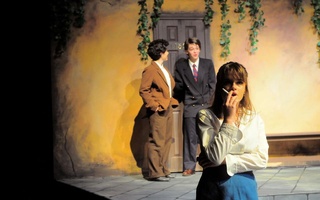On Friday night, the Hyperion Shakespeare Company put on a series of scenes from the Bard’s plays in Adams Pool Theatre. The decadence of the pool that existed, before its conversion to a small, intimate theater—and the tales of coed skinny-dipping and a few fabled orgies—is a stiff act to follow. Nevertheless, the dauntless Hyperion Shakespeare Company was the latest to take on such an endeavor and the verdict? Not bad. The Hyperion performed ten scenes, mostly well-known, from seven of Shakespeare’s plays, with all of the scenes based on the theme “Family Feud.” The production, which played through Saturday, isn’t going to win any awards as a whole, but ran refreshingly short and was supported by a solid, occasionally exceptional cast.
This performance consisted of a compilation of scenes, many with overlapping actors. The lights, set, and costumes were very plain, though not necessarily in a bad way; the simple construction lent itself well to a diverse range of scenes. Except for one spotlight on King Hamlet’s ghost, the lights were relatively uniform, with the actors always thoroughly lit. Costumes varied from character to character, ranging from completely black and white garb to conventional jeans and a T-shirt, for no easily discernible reason. Nonetheless, these choices were appropriate and contributed to a casual atmosphere in which the acting could stand on its own.
Despite the plain choices and simple production design, which could possibly have made the performance feel thrown together, a lack of technical errors revealed a capable but not extraordinary cast. The actors hit their cues and blocking and delivered their lines with attempted authenticity that is all the more difficult to pull off in iambic pentameter. However, the players did not in the end feel particularly authentic—certainly not spontaneous—and came off only as functional.
Despite the beige impression left by the cast, a few performances stood out. Caleb J. T. Thompson ’14, a Crimson arts editor, impressed in scenes from both “King Lear” and “Measure for Measure.” In the “Lear” selection, Thompson played the aging king struggling to decide how to divide his land among three daughters. Thompson’s subtlety with a slight and convincing stammer added staccato to a rich vocal performance. In combination with a slightly bent posture, Thompson read as elderly and deteriorating, creating memorable character in what could otherwise be a flat scene to read, much less perform. As Claudio in “Measure for Measure,” imprisoned and waiting for execution, Thompson does not read so authentically as a man facing death, but he strikes a tone between grave and comic that “Measure” classically occupies, adding nice relief to a generally dour lineup.
Another surprising relief from the tragedy and bitter family feuding came from Alex B. Zaloum ’16, who portrayed Polonius from “Hamlet.” In this scene, Polonius delivers the famous line “Neither a lender nor a borrower be,” imparting advice to his son Laertes (Kevin T. Wittenberg ’14) and daughter Ophelia (Lelaina E. Vogel ‘15). Zaloum’s portrayal of Polonius worked—acting sharp and vaguely creepy—and added an unexpected layer of comedy. Zaloum was purposefully rigid and slow; working with his height and slight frame, he appeared eccentric but severe, and his voice was smooth and drawling. His character’s eccentricity and deliberate actions built a mounting tension until Ophelia defied him and he unexpectedly lost it, only briefly, in a personal screaming match against himself. Zaloum’s ability to build tension between his comedy, physical and vocal, and his unexpected severity made the performance stand out.
With a capable cast across the board and even some exceptional performances, the Hyperion’s scene recital was disappointing mainly because the theme did not seem to tie the scenes together fully. The themed scene recital is a brilliant idea—the performance was quick-paced and punchy, running just over an hour—but the theme, “Family Feud,” was too broad (though having brothers Nathan O. Hilgartner ’14, a Crimson arts editor, and Kevin Q. Hilgartner ’16 play mortally feuding brothers Edmund and Edgar from “King Lear” was quite clever). Familial issues are prominent in every play by the Bard, and this production would have would have excelled with a more specific theme that built from scene to scene. The acting in “Family Feud” was successful, but the weak connection between the scenes and the overarching, progressing theme made the end product somewhat superficial. Just a little more central direction could have made it into a wonderfully cohesive cycle of Shakespearean scenes. Nonetheless, it was easily accessible, and its short length and quick pace made the production quite enjoyable for a wide audience.
—Staff writer Kurt P. Slawitschka can be reached at kurtslawitschka@college.harvard.edu.
Read more in Arts
Musical Gluttony And How To Suppress ItRecommended Articles
-
Degrees of Delight at the ExSix Degrees of Separation at the Loeb Ex March 16 and 19, 7:30 p.m. March 17, 7:30 and 9 p.m.
-
The Secret in Their EyesThe real mystery is how this movie ended up snatching any accolades at all, let alone the Oscar for Best Foreign Film earlier this year, and the Goya Prize last year—some of the highest in the industry.
-
Brutality With a Purpose in Brilliantly Directed ‘Cleansed’While such a tense, emotional atmosphere could feel overdone or monotonous, exceedingly skillful direction and impressive acting make “Cleansed” an indubitable success.
-
 'Shrew' Recasts the Bard Anew
'Shrew' Recasts the Bard Anew -
‘Betrayal’ Falls Flat Due to Emotionless ActingAlthough “Betrayal” ultimately disappoints, inspired direction and set design partially redeem the production.
-
Shel Silverstein Should Not Grow UpThe program for “An Adult Evening With Shel Silverstein,” which ran until August 31, forewarned the audience that the “show is not suitable for children.” This might seem like a surprising disclaimer to accompany the work of an author best known for child-friendly poems, but the play took on a lot, from wild obscenities, to killing horses, matricide, infanticide, and being raped by a bunch of Koreans (we never find out why the Koreans are in the story specifically, but it gets dwelled on).













